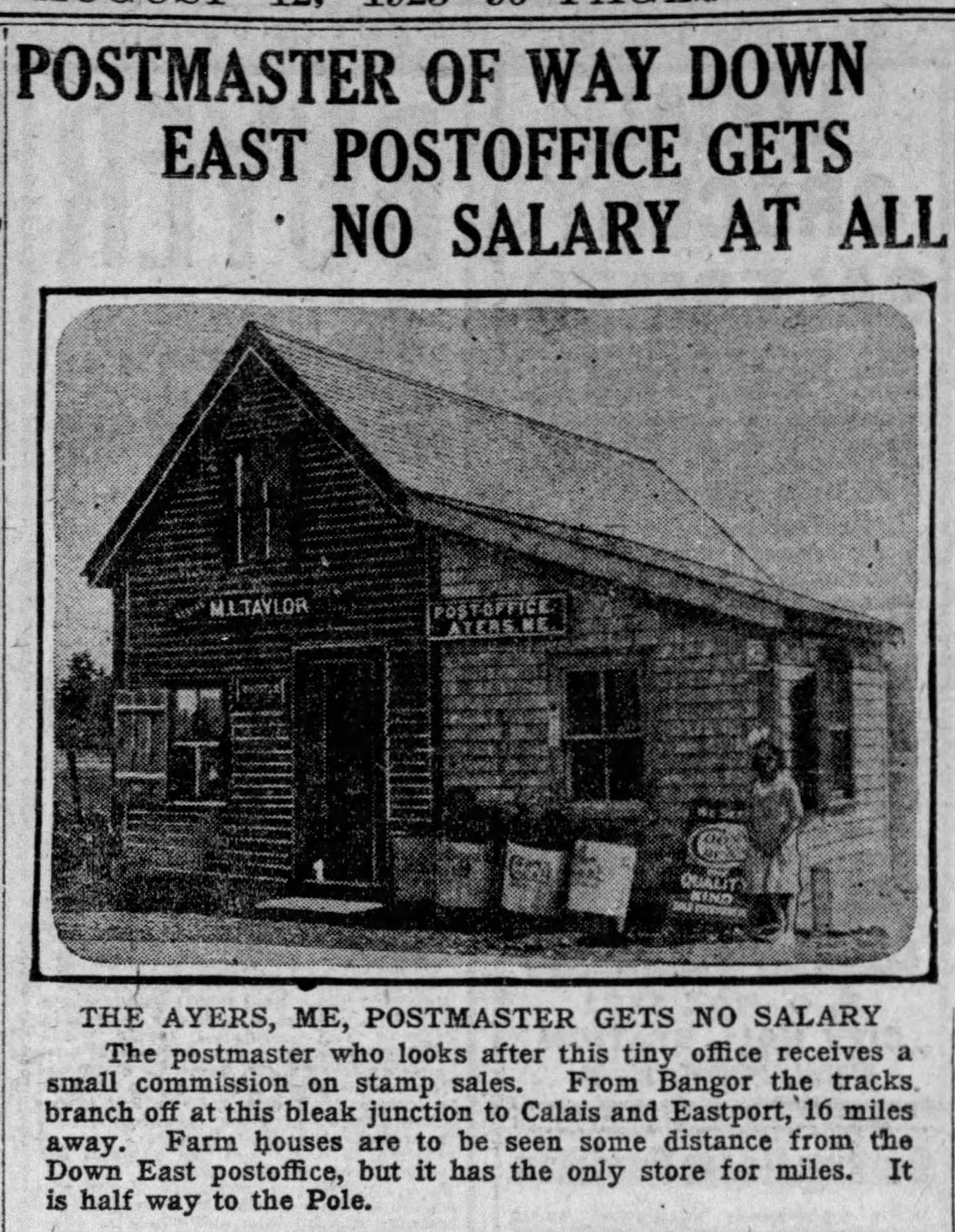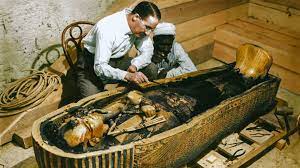
Harold Carter discovers the tomb of King Tut
In one of the few bits of good news of 1923 Egypt archaeologist Howard Carter discovered Tutankhamen’s tomb. Otherwise 1923 saw the gathering of storm clouds on the horizon.The political situation in Europe deteriorated dramatically after French and Belgian troops occupied the Ruhr, Germany’s economic heartland, to enforce the payment of war reparations by a German nation still unable to feed itself. This shortsighted policy accelerated the rise of Adolf Hitler who, days after the occupation, gave a speech advocating a policy of “hatred and more hatred” toward the Allies and Versailles peace agreement. Anyone who couldn’t see this was all going to end rather badly wasn’t paying attention. Later in the year Hitler led his “Beer Hall Putsch” which got him arrested and only increased his popularity. In the United States President Harding died in office and was succeeded by Calvin Coolidge who soon found himself embroiled in the Teapot Dome scandal. On one other positive note the first country and western hit was recorded “Little Old Cabin in the Lane”.
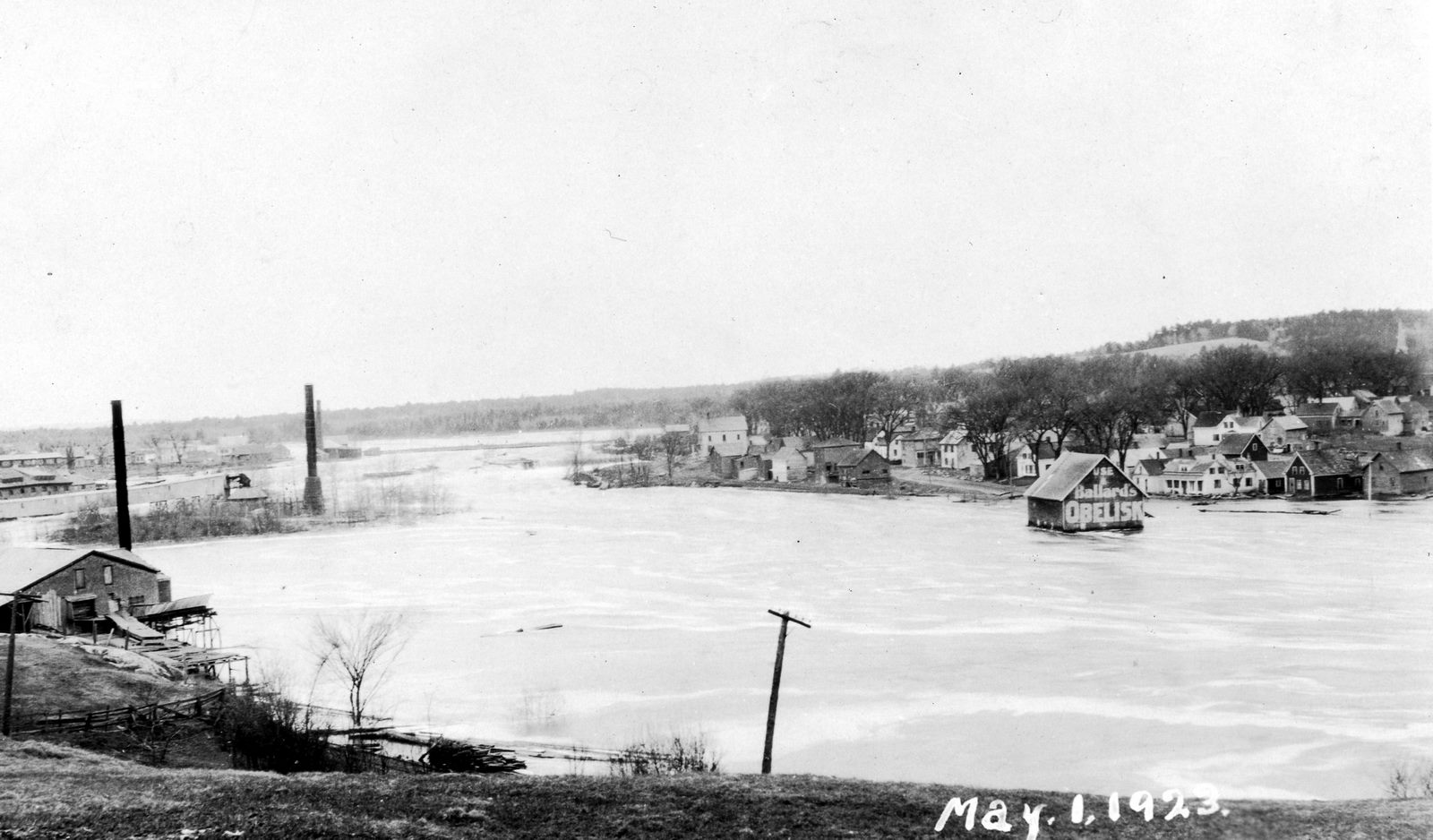
The Obelisk Building floats downriver from Milltown Bridge which has washed out. Milltown N.B. to top right.
1923 was also a rough year for residents of the St. Croix Valley. The winter was severe with more snow than usual but as spring arrived residents of valley cheered the ice going out, the extra hours of sunshine and warm days and those near the river were lulled to sleep by the steady murmur of the spring runoff. At the end of April that murmur became a roar as a record torrent of water coursed down the St. Croix resulting in a flood which first washed out the Baring Bridge, then the Milltown and Arch Bridges and finally the Union Street Bridge. Only the Ferry Point Bridge survived and then just barely. Water poured from the windows of Cotton Mill on the Canadian side.
The Calais Advertiser reported:
“The scene on the river in the vicinity of Milltown was one of wild grandeur, one no person ever witnessed on the St. Croix before, and it is doubtful if they will ever witness the likes again on these waters. The banks of the river were crowded all day Tuesday with spectators and the interest has not yet subsided.”
The Bangor Daily described the flood and devastation on May 7th, a week after the flood.
Never in the history of the Saint Croix valley has so much damage been done by water as that which poured down upon the community on Monday and Tuesday April 30th and May 1st. Huge quantities of snow from hill and valley melted by the first rays of spring, emptied into the Saint Croix river and is tributaries and so swelled the river that the highest watermark was smashed all to pieces, and the Saint Croix river went on a rampage, overflowed its banks and places and did an enormous damage to property and while it endangered many lives in its mad rush, fortunately nobody was drowned in this section.
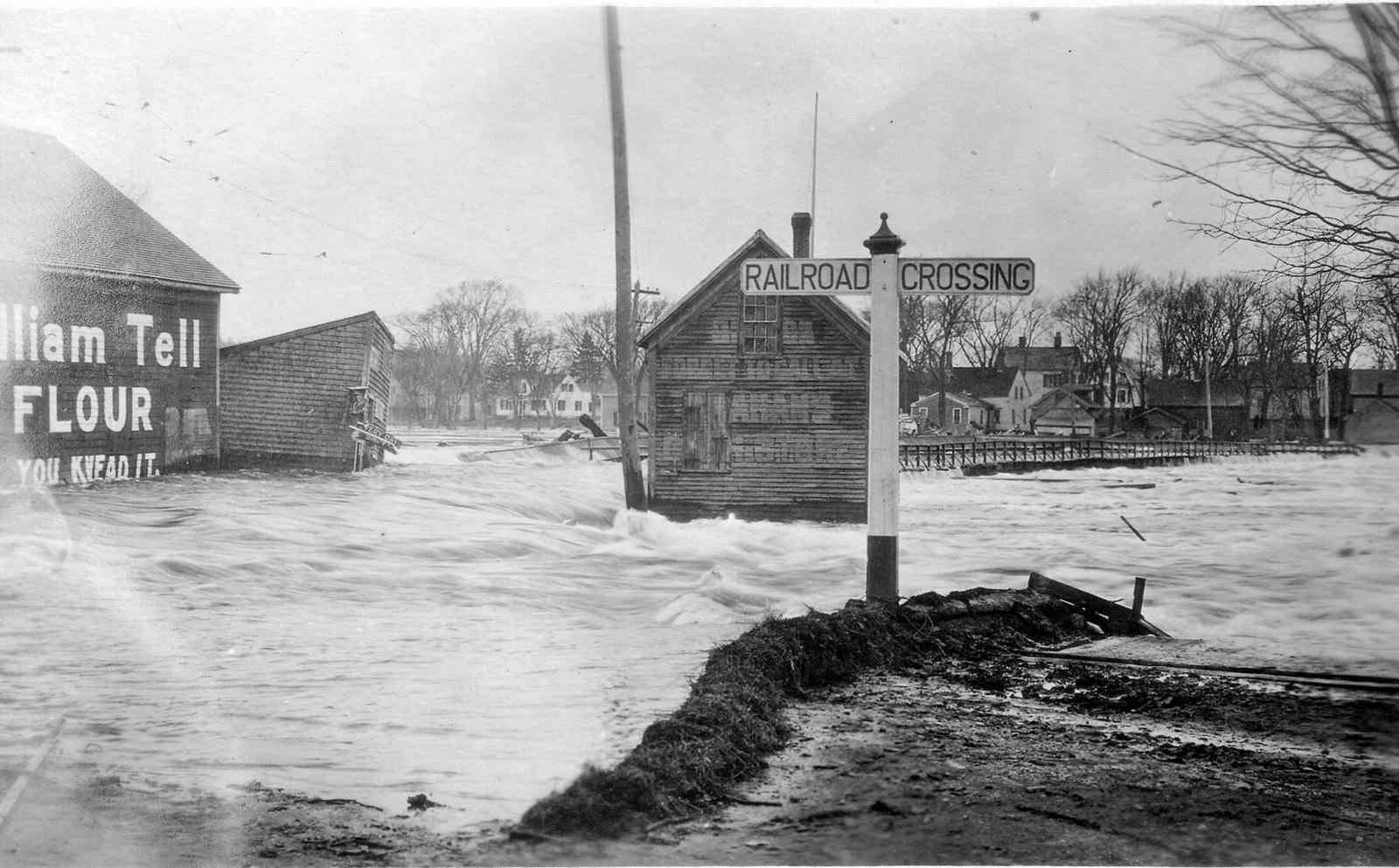
U.S end of Milltown Bridge underwater; building in center went downriver
The water piled high and with great force against the highway bridge that connects Calais, Maine with Milltown, New Brunswick and washed over both sides of it, but it withstood the force until Friday when the Calais end washed out.
At this point US customs officer Edward Welch, when he found the water was rising at a rapid rate, was forced to leave the customs house building at the end of the bridge. That night the building was forced from its foundation and sailed down the river where it came to rest near the Eaton sawmills.
Further down the river, the international railroad bridge, the so-called trestle bridge that runs across the river from the American side at Knight’s corner to Milltown New Brunswick near the cotton mill, used by the Maine Central and Canadian Pacific railroads for transferring cars from Canada to the United States was lifted from its foundations and washed down river where its timbers floated against the highway bridge that connects Calais with the Union which is a part of Milltown New Brunswick washed that structure from its foundation, also the US customs house, where customs officer Lloyd Hill, was forced to make a hasty exit. The bridge and customs building forced the planing mill, used by the Canadian Realty company, but owned by the Todd estate, from its foundations and all three sailed down river but were fortunately so broken up there by the time it reached the international bridge, which connects Calais with St. Stephen, the shock of the structure was very light. Later in the evening the other mill close to the planing mill, and the property of the Todd estate was also washed away; the damage to the property at this section was large.
The greatest damage was in Milltown New Brunswick just across the line from Calais, where the big mill of the Canadian Colored Cottons Limited was deluged with water, which reached a depth of 10 feet inside the mill, stilling the machinery and driving 750 employees from their posts of employment. John McFarlane, Alan McDonald, Edward Carver and Dick Boyd, who were the last to leave their work and were obliged to wade waist high through the rushing stream that poured through the cloth finishing room, sweeping unfinished and finished cloth in its path and damaging valuable machinery. The water kept on and through the new weave shed where more extensive damage was done to cloth in the making and valuable machinery. So great was the force of the water that the brick wall of the building was forced out and a portion of the roof caved in, and some machinery was washed away.
The loss of the mill’s machinery etc., will reach about one and a half million dollars, besides throwing 750 people out of employment for several months. The railroad bridge that connects Baring Maine with Upper Mills New Brunswick was washed away and lodged between Chase’s two sawmills, where it broke up.
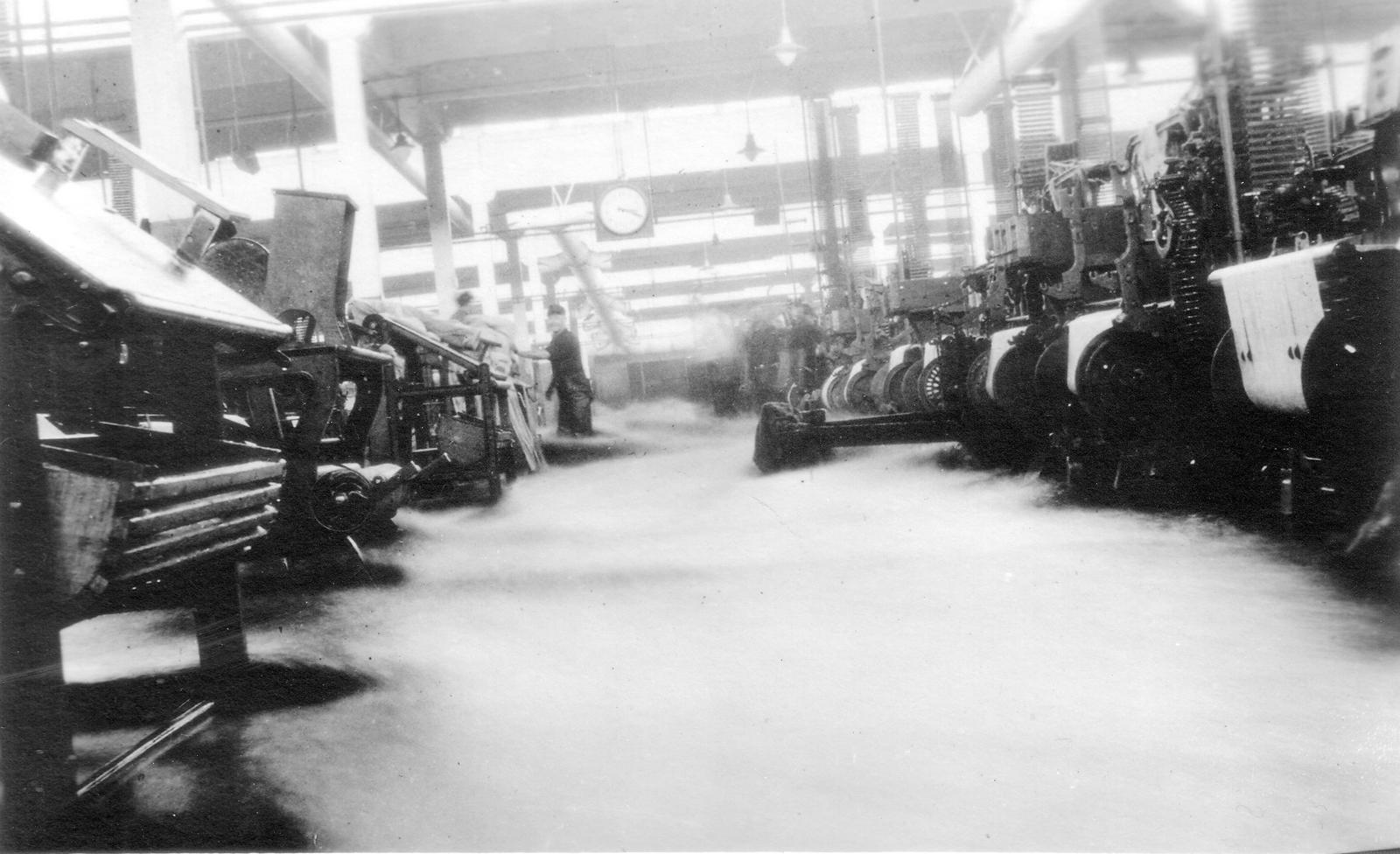
In other news from 1923:
The population of Calais was 6084, Woodland 2243, St Stephen and Milltown 6257, Robbinston 747, Eastport 2243, Danforth 1201, and Princeton 934. In the fall of 1923, Calais schools had 1175 students, Woodland 665 and Baring 34.
Frank Beckett had an adventure on the Cooper Road when returning from Machias one evening in 1923 when his car broke down. He waited for another vehicle to pass but none did the entire night so at seven in the morning he struck off to find a house which he soon did and called for help. When he returned to his vehicle someone had stolen his spare tire, tube and rim, all his tools, pump and even the floor mats and part of the floorboards of his car.
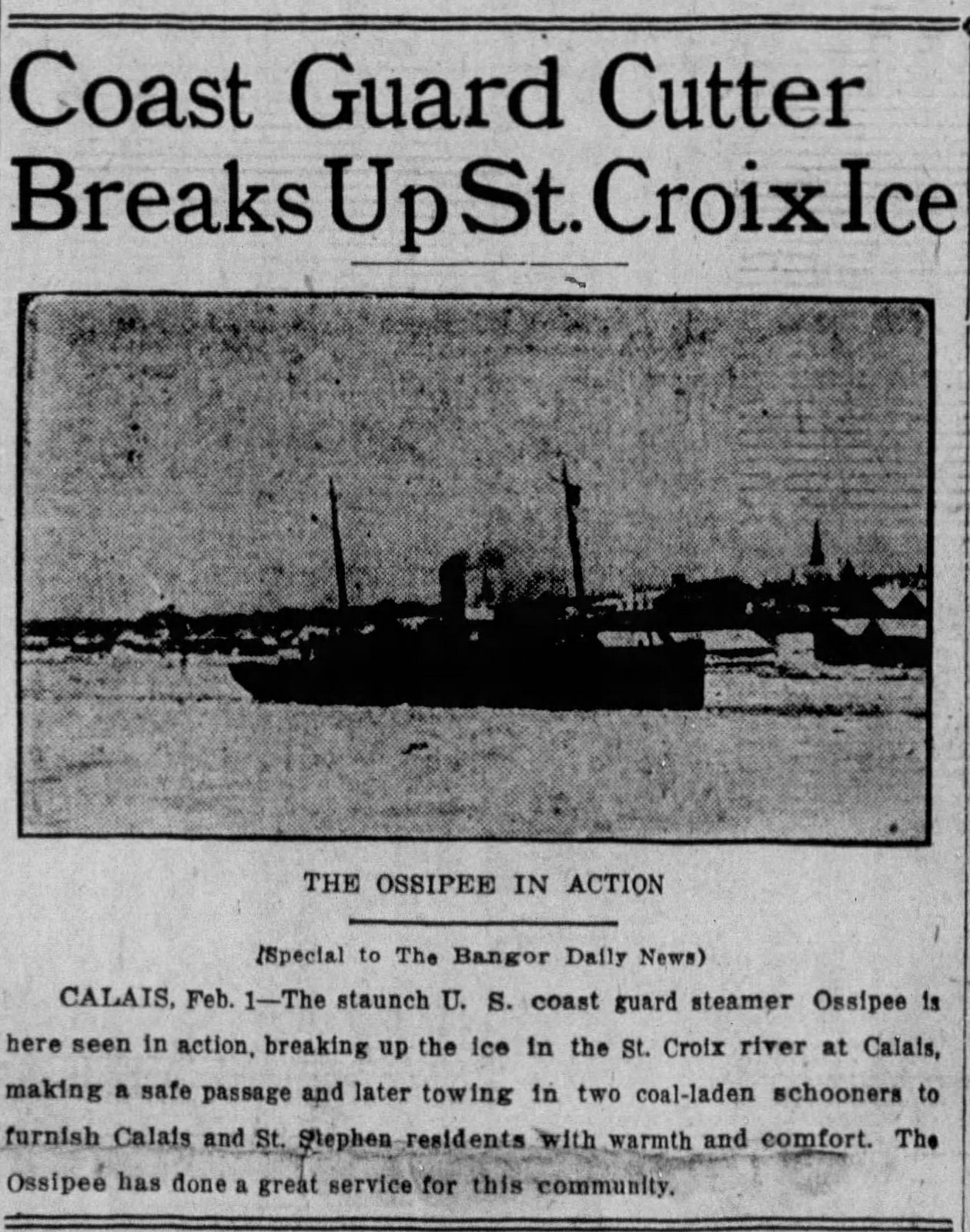
1923 – There was almost no coal left in Calais and St. Stephen.
The winter of 1923 had been bitterly cold. The icebreaker Ossipee had to clear a channel to allow coal laden schooners to reach Calais and St. Stephen. You ask, “Was it really that cold in 1923?” Apparently. The Miami News reported, rather more gleefully than necessary, receiving a letter from Edward Chase of Baring describing the brutal conditions Downeast including six feet of snow and temperatures of 20-30 below on several occasions. On March 12, 1923, the Portland Press Herald reported:
The St. Croix River and Passamaquoddy Bay, where there is always a strong current, have been entirely frozen over at times during February. This is a very rare occurrence. Early this week James and Robert Golding and Mr. and Mrs. William Tucker of Perry crossed the Bay on the ice, walking from Morgan’s Head in Perry, Maine to Saint Andrews, New Brunswick, a distance of two miles. They took a canoe with them on a toboggan, as a precaution but did not have to use it. Two men also crossed from Bayside on the Canadian side of the river to Lamb point on the Maine shore, coming ashore at Harville beach. They brought no boat and reported seeing no open water. They returned late in the afternoon of the same day.
On July 3rd, 1923, the Bangor Daily announced a Bangor concern planned to open “Big Pulp and Paper Mills on the St. Croix River” in Milltown and Baring. Nothing came of the plans.
In Robbinston Edward Crowell was sentenced to life in prison at hard labor for the murder of his wife and in November 1923 the Bangor Daily News reported the fatal shooting of Viola Smith at the Suddy farm in Robbinston where she had been a housekeeper. The circumstances were mysterious. Mr. Suddy, a Syrian, claimed he had many enemies who were jealous of his success as a farmer and that he was much disliked by his neighbors. Although the explanation that the shot was probably a stray bullet fired by a hunter didn’t wash with the authorities and they claimed an arrest was expected none was ever made.
1923 saw a typhoid epidemic in Princeton.
Prohibition having recently been enacted there were many reports in the papers of arrests of smugglers and bootleggers. On July 13, 1923 Ralph Story and William Woodruff of Princeton were caught by the authorities on the Alexander Road with 228 quarts of whiskey. Minutes before they had come across the Milltown Bridge. A third man in the vehicle escaped into the woods.
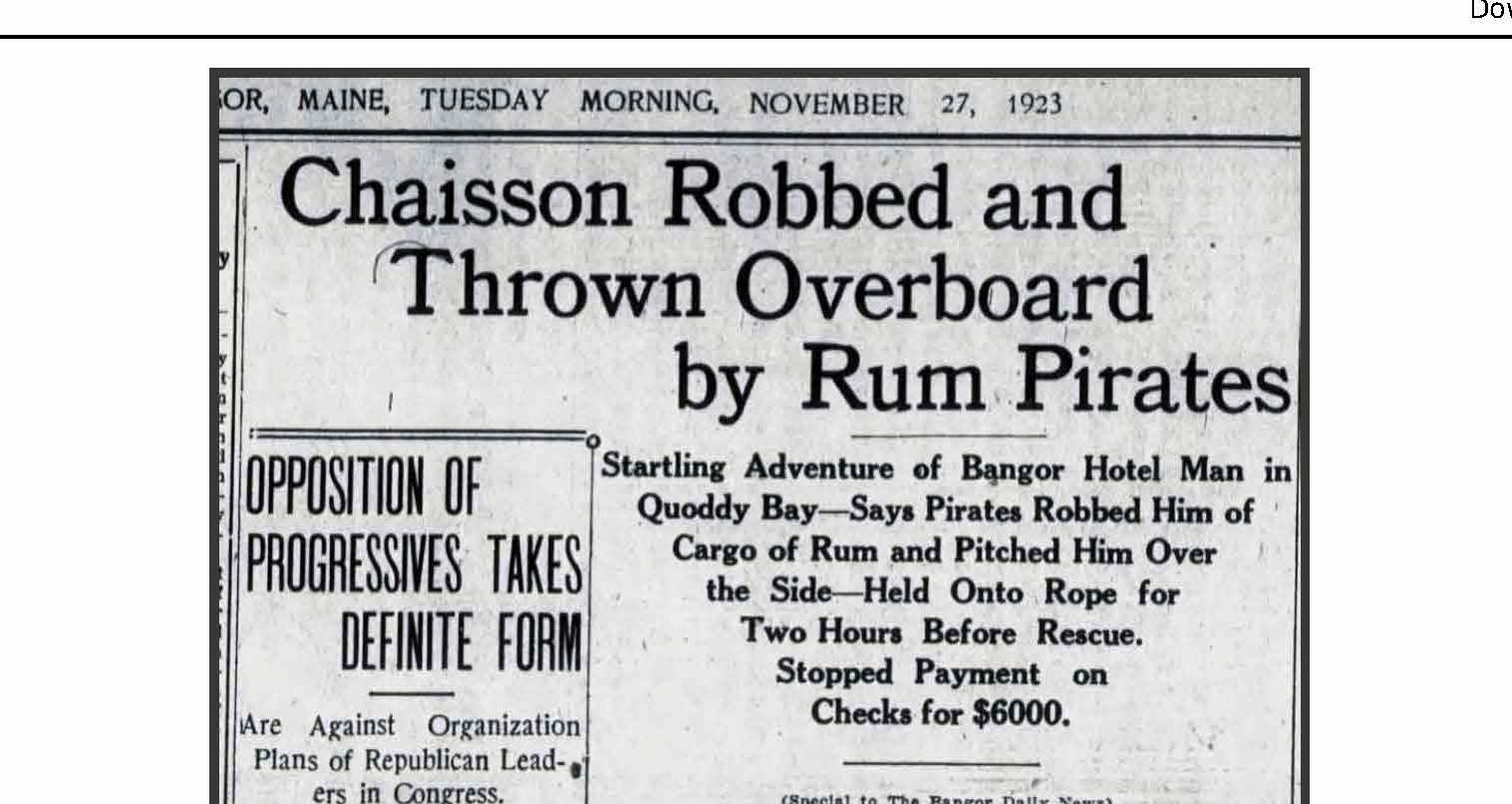
Bangor Bootlegger runs into pirates Downeast
Passamaquoddy Bay was the primary conduit for illegal booze coming across the border and it could be a dangerous business. Consider the near death of Victor Chaisson from Bangor who, as a hotelier, was expected to keep an ample supply of booze in stock for his guests.
BDN MAINE TUESDAY MORNING NOVEMBER 27, 1923,
Chaisson Robbed and Thrown Overboard by Rum Pirates
Startling Adventure of Bangor Hotel Man in Quoddy Bay — Says Pirates Robbed Him of Cargo of Rum and Pitched Him Over the Side — Held Onto Rope for Two Hours Before Rescue Stopped Payment on Checks for $6000
Special to The Bangor Daily News
LUBEC Nov 26— Victor T. Chaisson a Bangor liquor dealer and hotel proprietor was found at 5:40 this morning clinging to a rope attached to the bow of a sloop anchored in Snug Cove on the Canadian Island of Campobello directly opposite Lubec and was rescued by Charles Greenlow of Eastport who had heard his cries for help. Chaisson was brought to Lubec in an unconscious condition having been in the water two or three hours and when revived told a story of assault and robbery by two young pirates who after taking from him a cargo of liquor threw him overboard. The first thing Chaisson after recovering his senses did was to request the superintendent of the Sea-coast Packing Co here to telephone to the Eastern Trust Bank in Bangor to stop payment on two checks of $3000 each and it is supposed, although he did not so state, that the men who attacked him took these checks. His watch and $45 in cash remained in his pockets, also a bank book showing a balance of $20,000.
Later in the day Chaisson said his name was Smith although all the documents in his pocket bore the name of Victor T Chaisson and it has been ascertained that he is the Bangor hotel man without doubt. An immense bunch of Yale keys attached to a tag bearing the initials V.T.C. also was found in his pocket.
The boat to which Chaisson was found clinging is a thirty-foot sloop hailing from St. Stephen and she was in port at Lubec all day Sunday with a St. Stephen pilot who has since disappeared. It is thought that the cargo of liquor of which Chaisson says he was robbed was bought in St Stephen and that the Campobello pirates got word that he was coming down the bay with it and attacked him late Sunday night or early this morning after he had left Lubec. Another report is to the effect that Chaisson bought hls rum cargo from the pirates and gave them the checks for $6000 in payment and that afterwards the pirates threw him overboard, transferred the liquor to their own boat and disappeared, supposing that he had swam ashore or perhaps drowned. Tonight, Chaisson was waiting for a motor car from Bangor in which he intended to return to that city, but it was plain that he was in no condition to travel. He complained of severe pains in his back chest and legs.
Chaisson survived but didn’t reform. A year later the Bangor Daily reported that scotch valued at $5000 was found “cleverly concealed in a garage on Victor Chaisson’s farm on Ohio Street Bangor” and he continued as a bootlegger until his death in the early 1930’s. As owner of the Victoria Hotel on Exchange Street in Bangor, he probably had no choice as a dry hotel was an empty hotel during Prohibition.
The Daily News of Fall River, Mass reported the appointment by Canadian customs of its first female customs officer to “halt smuggling in women’s clothing”. The appointment was made at the insistence of merchants in Saint John and Fredericton and caused quite a stir on the border. The Bangor Daily provided the grisly details of this unprecedented assault on our border community:
Bangor Daily 22 January 1923:
Shoppers Searched on Border
Special Woman Inspector Employed at St. Stephen by Canadian Govt
Have Been Buying Garments in Calais and Wearing Them Across
International Bridge Officers Are Kept Busy Keeping Traffic Clear During the Proceedings
Special to The Bangor Dally News) CALAIS, Jan. 21
Mrs. White, a special inspector from the Canadian customs department in Ottawa, made things unpleasant for women shoppers Saturday night as they crossed the international bridge from Calais to St Stephen. Every woman who carried a parcel or shopping bag was requested by the customs officer in charge to step in and she was escorted to a rear room where she was searched by Mrs. White. Several expensive coats and silk dresses were levied upon. If the coat cost retail, $40, she charged them $40 plus the duty. One woman said she had to pay $28 and another $21. This Is the first time in border history that a woman has been employed in catching smugglers on the border.
This affair created so much attention that despite the cold, large crowds gathered in front of the Canadian office to get a glimpse of what was going on. It kept Officer Cleghorn busy keeping the sidewalk clear. One girl said confidentially she even searched my bloomers. It is said that the reason that the woman sleuth is on the border, is that St. John, Woodstock and Fredericton merchants ladies’ garment business has fallen off on account of there being so much business in Calais, and that many of their customers took the train, shopped in Calais, wore the clothing over, and everything was clear sailing.
Mrs. Matilda Wallace of Calais observed her 102nd birthday. On her 101st birthday a year earlier all of the town’s notables showed up at her home to wish her a happy birthday including a Justice of the Maine Supreme. It was said in an Advertiser article that she still did housework, ironing and helped cook the family meals.
In a distant echo of the recent NFL player who was near death from cardiac arrest after making a tackle, Andrew Beers, age 22, died after being struck in the chest by a baseball during a game in Milltown New Brunswick. Other than smuggling, the local pastime was sports and all the towns had baseball, football and basketball teams. Rivalries were fierce. In 1923 Calais even tried to put a hockey team on the ice to compete against the fanatics across the border. This was a short-lived venture, but baseball games especially inspired fierce loyalties and large crowds. The Brunswick Times Record and other papers reported on Calais fan, Harold Crossman, who vowed while attending a game in St. Stephen that he would walk barefoot on the hot August pavement the two miles to his home if Calais won. Calais won and Harold arrived home with blistered feet. There is some indication that the umpires were not entirely impartial. St. Stephen forfeited a game to Calais in protest over the umpire selected by Calais, the home team.
In other local news there was fierce opposition to a bill pending before the Maine legislature mandating a maximum 48-hour work week for women which, it was claimed, would put Maine at a competitive disadvantage with Southern cotton mills and shoe factories. John Goode, a customs inspector, got five months in the county jail for assisting another local, Roy Sadler, in a wool smuggling racket. We suspect no one was too surprised to discover there was smuggling going on in the valley. Alienation of affections was still a crime: a St. John man was in Bangor jail after coming illegally across the Calais border to meet another St. John man’s wife in Bangor. Cigarettes were 15 cents a pack, cheaper by the carton, and Lord’s Drug Store sold Vicks VapoRub as a cure for headaches: “rub forehead, temples and back of the neck with Vicks” and the headache would disappear. Finally, in a reminder that the days of sail and the attendant uncertainties of life before the mast were not entirely a thing of the past, the schooner Hyena owned by Boardman and bound for Calais with a load of coal ran aground near Gloucester, Mass. The captain and a seaman drowned while the rest of the crew managed to reach shore in very poor condition.
National newspapers reported the astounding news that “Twins, real bonafide twins” had been born to a couple at Pleasant Point. The paper went on to say, “Twins are very seldom, if ever, found among Indians anywhere and never before in the 156 years in which Passamaquoddies have been settled along the border between the United States and Canada have twin babies been found among them.” The father of the twin girls is reported to have been ‘William Soccobie, noted athlete and marathon runner.”
Finally, an of item from Eastport:
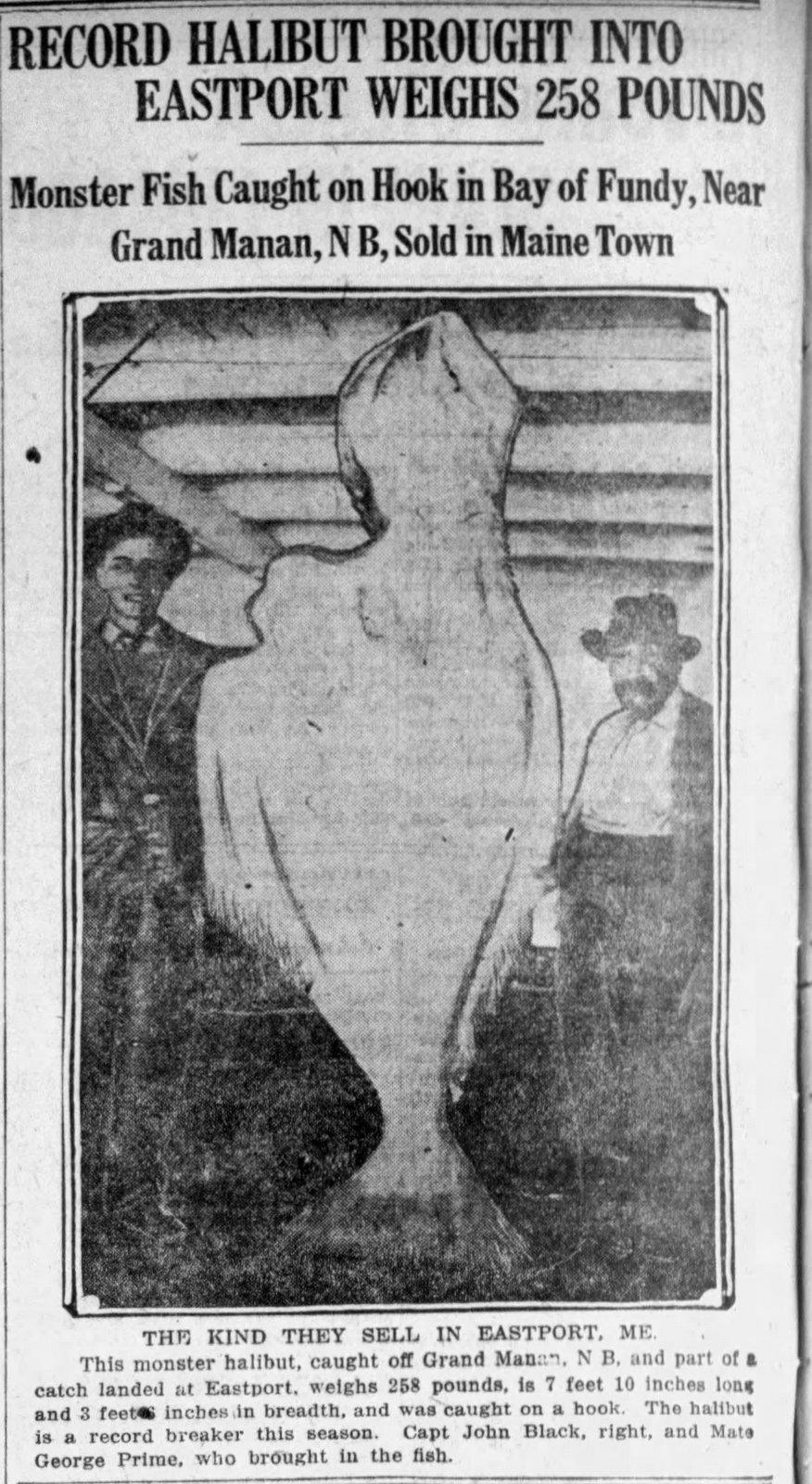
And the “bleak junction” of Ayers Maine.
